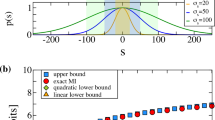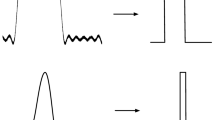Abstract
A novel method is presented for calculating the information channel capacity of spike trains. This method works by fitting a χ-distribution to the distribution of distances between responses to the same stimulus: the χ-distribution is the length distribution for a vector of Gaussian variables. The dimension of this vector defines an effective dimension for the noise and by rephrasing the problem in terms of distance based quantities, this allows the channel capacity to be calculated. As an example, the capacity is calculated for a data set recorded from auditory neurons in zebra finch.





Similar content being viewed by others
References
Anderson, T. W., & Darling, D. A. (1952). Asymptotic theory of certain ‘goodness-of-fit’ criteria based on stochastic processes. Annals of Mathematical Statistics, 23, 193–212.
Bialek, W., Rieke, F., de Ruyter van Steveninck, R. R., & Warland, D. (1991). Reading a neural code. Science, 252, 1854–1857.
Borst, A., & Theunissen, F. (1999). Information theory and neural coding. Nature Neuroscience, 2, 947–957.
Cover, T. M., & Thomas J. A. (1991). Elements of information theory. Wiley.
De Ruyter Van Steveninck, R. R., Lewen, G. D., Strong, S. P., Koberle, R., & Bialek, W. (1997). Reproducibility and variability in neural spike trains. Science, 275, 1805–1808.
Dubbs, A. J., Seiler, B. A., & Magnasco, M. O. (2009). A fast \(\mathcal{L}_p\) spike alignment metric. arxiv/0907.3137.
Houghton, C. (2009a). A comment on ‘a fast l_p spike alignment metric’ by A. J. Dubbs, B. A. Seiler, & M. O. Magnasco. arxiv:0907.3137, arxiv/0908.1260.
Houghton, C. (2009b). Studying spike trains using a van Rossum metric with a synapses-like filter. Journal of Computational Neuroscience, 26, 149–155.
Houghton, C., & Victor, J. (2010). Measuring representational distances—The spike-train metrics approach. In N. Kriegeskorte, G. Kreiman (Eds.), Understanding visual population codes – toward a common multivariate framework for cell recording and functional imaging. MIT Press (in press).
Johnson, D. H. (2003). Dialogue concerning neural coding and information theory. http://www.ece.rice.edu/~dhj/dialog.pdf.
Narayan, R., Graña, G., & Sen, K. (2006). Distinct time scales in cortical discrimination of natural sounds in songbirds. Journal of Neurophysiology, 96, 252–258.
Rieke, F., Warland, D., De Ruyter Van Steveninck, R. R., & Bialek, W. (1999). Spikes: Exploring the neural code. MIT Computational Neuroscience Series.
Rubin, I. (1974a). Information rates and data-compression schemes for Poisson processes. IEEE Transactions on Information Theory, 20, 200–210.
Rubin, I. (1974b). Rate distortion functions for non-homogeneous Poisson processes. IEEE Transactions on Information Theory, 20, 669–672.
Shannon, C. E. (1948). A mathematical theory of communication. Bell Systems Technical Journal, 27, 379–423, 623–656.
Silverman, B. W. (1986). Density estimation. London: Chapman and Hall.
Stephens, M. A. (1974). EDF statistics for goodness of fit and some comparisons. Journal of the American Statistical Association, 69, 730–737.
van Rossum, M. (2001). A novel spike distance. Neural Computation, 13, 751–763.
Victor, J. D. (2002). Binless strategies for estimation of information from neural data. Physical Review E, 66, 051903.
Victor, J. D. (2005). Spike train metrics. Current Opinion in Neurobiology, 15, 585–592.
Victor, J. D., & Purpura, K. P. (1996). Nature and precision of temporal coding in visual cortex: A metric-space analysis. Journal of Neurophysiology, 76, 1310–1326.
Wang, L., Narayan, R., Graña, G., Shamir, M., & Sen, K. (2007). Cortical discrimination of complex natural stimuli: Can single neurons match behavior? Journal of Neuroscience, 27, 582–589.
Acknowledgements
JBG wishes to thanks the Irish Research Council of Science, Engineering and Technology for an Embark Postgraduate Research Scholarship. CJH wishes to thank Science Foundation Ireland for Research Frontiers Programme grant 08/RFP/MTH1280. They are grateful to Garrett Greene, Louis Aslett and Daniel McNamee for useful discussion and to Kamal Sen for the use of the data analysed here.
Author information
Authors and Affiliations
Corresponding author
Additional information
Action Editor: Aurel A. Lazar
Rights and permissions
About this article
Cite this article
Gillespie, J.B., Houghton, C.J. A metric space approach to the information channel capacity of spike trains. J Comput Neurosci 30, 201–209 (2011). https://doi.org/10.1007/s10827-010-0286-8
Received:
Revised:
Accepted:
Published:
Issue Date:
DOI: https://doi.org/10.1007/s10827-010-0286-8




